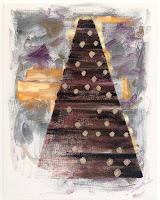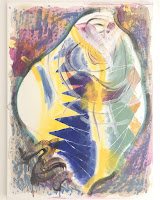: READ PRESS RELEASE :
Under the Cedar Tree
24th July - 4th October 2022
Athelhampton Road, Dorchester
Dorset
EXHIBITION OVERVIEW
The
manor at Athelhampton was recorded in the Domesday Book as being held by
Aethelric. Centuries after 1086, Athelhampton enjoyed Tudor prosperity with the
construction of the Great Hall, but Reformation, Civil War, a wicked Regency
owner and World Wars followed. The House and its Gardens now are recognised as
one of the most important Stately Homes in the south of England. Today,
Athelhampton is propelled into the twenty first century with its ambitious
Carbon Zero objectives, which will protect the Tudor house for generations to
come. Despite having so many stories to tell, Athelhampton still has many
mysteries concealed within its walls!
The
abstract paintings in this exhibition explore the significance of Athelhampton
today and attempt to capture the atmosphere of this historical site in a
contemporary, twenty-first century manner. The artist, Belinda Smith, has found
inspiration in certain features of the house, such as the splendid plaster
ceilings, fireplace carvings and stained glass windows, in addition to the
separate sections of the Gardens which include The Corona, The Great Court and
the Private Garden as well as the Lion’s Mouth.
Athelhampton’s
unique arrangement of picturesque pleasure gardens were the vision of landscape
architect Francis Inigo Thomas (1865 - 1950). In 1891 he was commissioned by
the then-owner of Athelhampton, Alfred Cart de Lafontaine, to design gardens
reflecting the popular tastes of the time; namely that ancient manor houses,
particularly with Tudor influence, held inherent value worthy of restoration
and preservation. Although the Gardens have seen numerous changes since the
last century, visitors can still appreciate much of Inigo Thomas’ original
style which both compliments and draws imagination from the architectural
features of Athelhampton House itself.
Although
Belinda’s paintings may not physically represent or capture the appearance of
the gardens or of rooms of the house, they offer a contemporary viewfinder on
some of the stories that shape the identity of the estate. A number of
paintings reference different historical characters and how they have either
found inspiration from or left their personal stamp on Athelhampton over the
years. Several artworks are even dedicated to previous owners and residents.
The
paintings in this exhibition are located throughout the estate and encourage visitors
to further explore the gardens and lesser-known parts of the house. Starting in
the Great
Chamber visitors can see side by side a painting of the pyramidal
yews of the Great Court by the artist Marevna and Belinda’s abstract
interpretation of her cubist style. Upon exit of the Great Chamber, visitors
may take the Spiral
Staircase to the left. Follow the trail of paintings to the very
top!
Up
on the Second
Floor Landing visitors can see two paintings inspired by
Athelhampton’s Regency owners. In the Long Attic Gallery, the room to the left at
the top of the stairs, paintings and framed drawings influenced by the estate’s
history are on display. A group of four paintings in the Small Attic Gallery at the other
end of the landing are dedicated to the Martyn sisters.
Outside
in the Gardens, the two Pavilions of the Great Court feature large
scale paintings inspired by the changing of the seasons. Meanwhile, artworks in
the Kitchen
Garden Glasshouse explore Inigo Thomas’ frequent use of the
pyramidal shape - a theme of particular significance this year in the centenary
of the discovery of the tomb of Tutankhamun. Additionally, framed Athelhampton
Miniatures are displayed in the gift shop.
ARTIST’S STATEMENT
In these paintings I have searched for
connections between the Gardens and some of the history of Athelhampton. As
such, the shapes and forms employed by Inigo Thomas have taken on new meanings
and relationships with one another.
In the painting Stone Crown Elegy the Jacobean inspired shapes of the Corona Garden
merge with the format of a historical, coded letter to draw attention to the
fate of Chidiock Tichbourne. The paintings de
Lafontaine’s Fountain: I-III reflect the shape of the Great Court’s central
pond and investigate this gentleman’s enigmatic identity. The Lion’s Mouth
garden finds itself the centrepiece of Tresco
Lion, a painting relating to 15th century armour and the tales of Hercules.
The pyramidal forms frequently found in the Gardens are angled in a selection
of artworks so as to reach beyond the estate’s integration. Referencing the
Martyn effigies at Puddletown, the Pyramidal
Pilgrim artworks are on display in the Kitchen Garden Glasshouse.
Reminiscent of ancient Egyptian tombs, Mayan and Cambodian Temples and the
Argolis Pyramids of Greece, these artworks are also linked to paintings by
Marevna and the prose of Thomas Hardy, a good friend of de Lafontaine, and
whose initials can be found on the lintel of the culver dovecote.
I have not tried to rewrite history in
these paintings but to find a thread of connectivity running between the
present and this ‘Seated Old Relic’. This thread has undoubtedly crossed over
many paths and this is perhaps the very value of abstract painting. Unlike a
photograph which captures a singular moment in time, an abstract painting
enables many connections to be made within a storyline. It offers a chance to
hold onto a moment from the past in a physically tangible way whilst
referencing topical concerns of the world of today. We come, often on holiday -
enjoying our free time - to view historical homes and all their mystery and
majesty. The tradition of painting is malleable enough to interpret these
histories in the context of today’s myriad concerns; from climate change, the ecological
crisis, the destruction of Nature, the often frightening effects of
mass-consumption, exponential population growth, disease and war to the
fictitious dangers and paradoxical benefits of our Digital Age. Indeed, the
storyline of the Martyns has not ended with their departure from Athelhampton,
but provides the very backdrop of historical house and garden.
The unique opportunity of being able to
exhibit these paintings upon the very walls which provided their inspiration -
whether it be a person, a stained glass window or the feeling of a restless
spirit - adds to this thread of connectivity. When I first visited Athelhampton
I knew it was a house still breathing, still living, as much alive inside as
the Gardens are outside. I think it is only through paint that this can be
celebrated and communicated. Even if not
all aspects of the estate’s history and previous residents are known today,
painting lends itself very well in the search to discover those questions which
may not have full or complete answers. The estate does not always reveal its
true self and it is through this withheld, or unrequited gift, that so many
continue to find delight and enjoyment in visiting Athelhampton House and
Gardens.
July 2022





















.jpeg)









,%202022,%20Acrylic%20and%20Oil%20on%20Canvas,%2041%20x%2051%20cm,%2016%20x%2020%20Inches.jpg)



